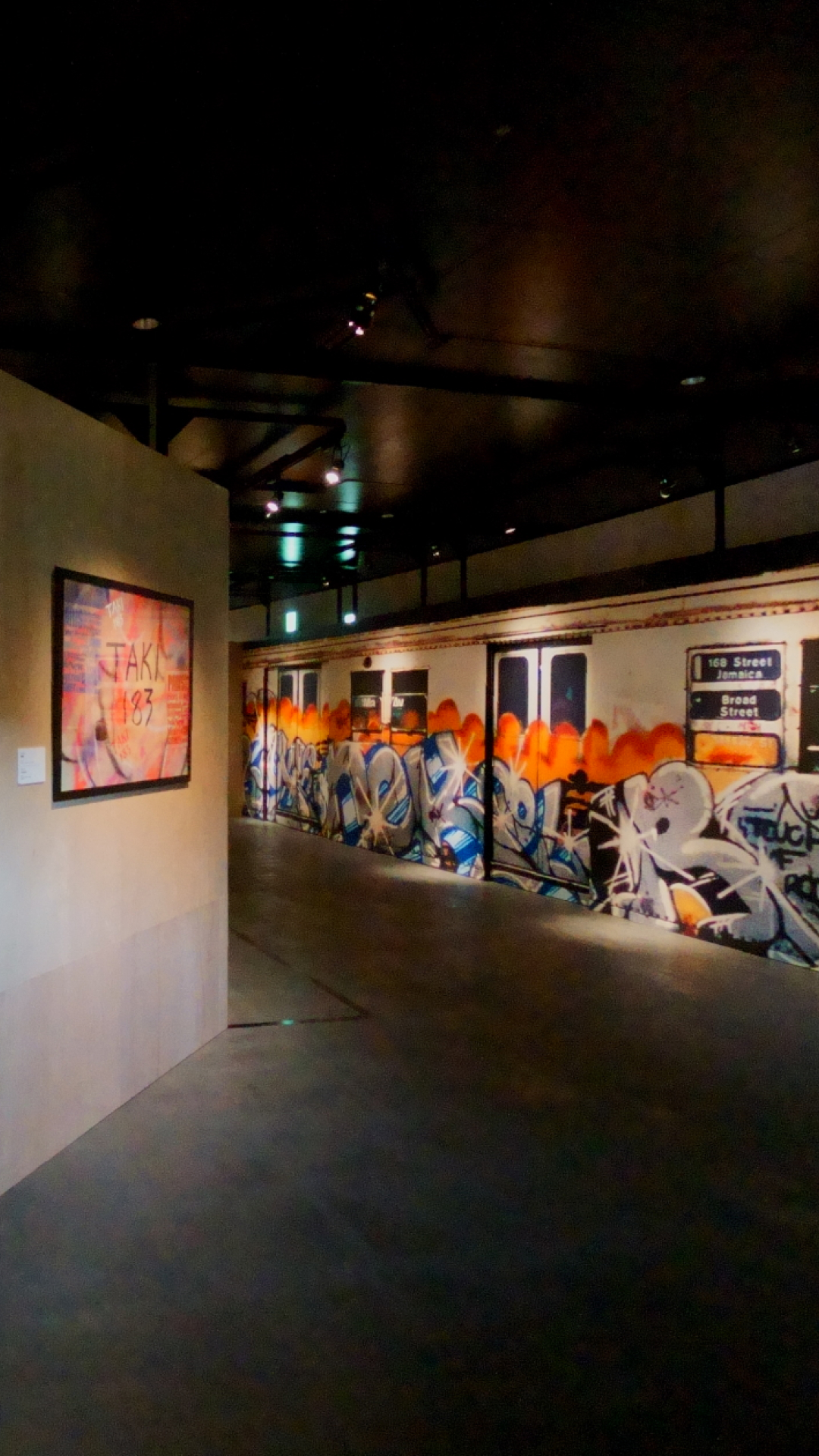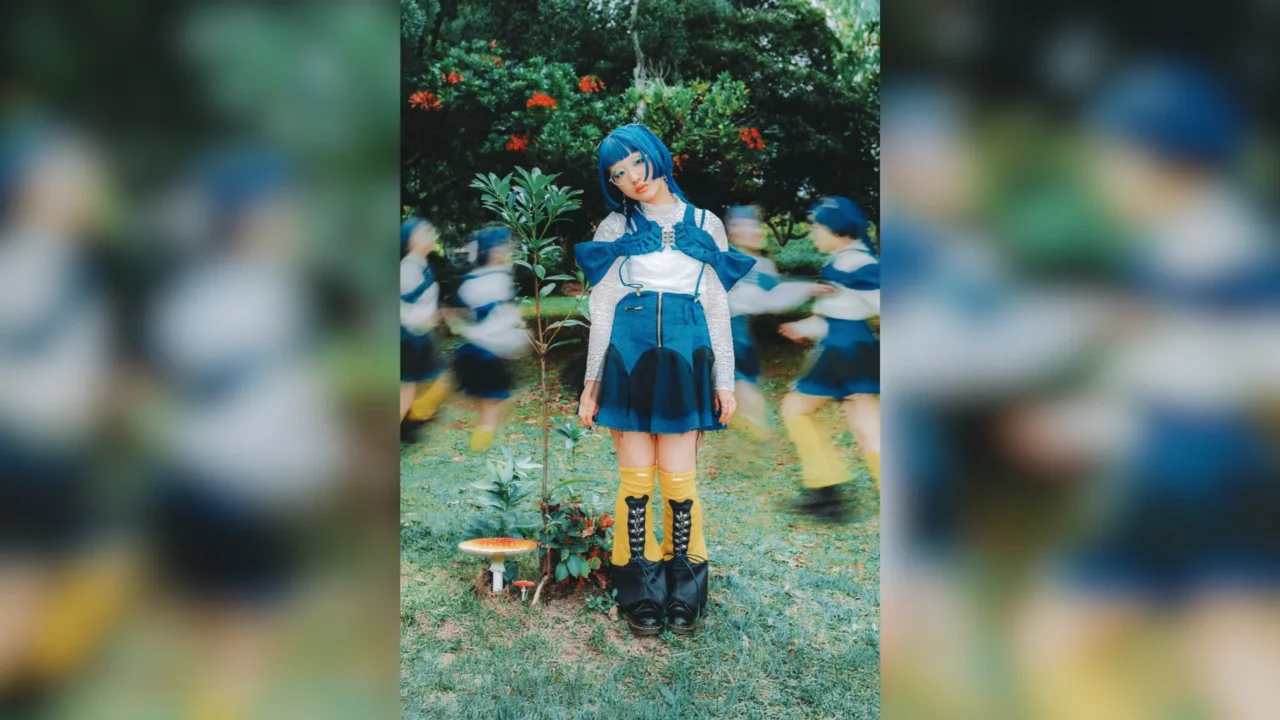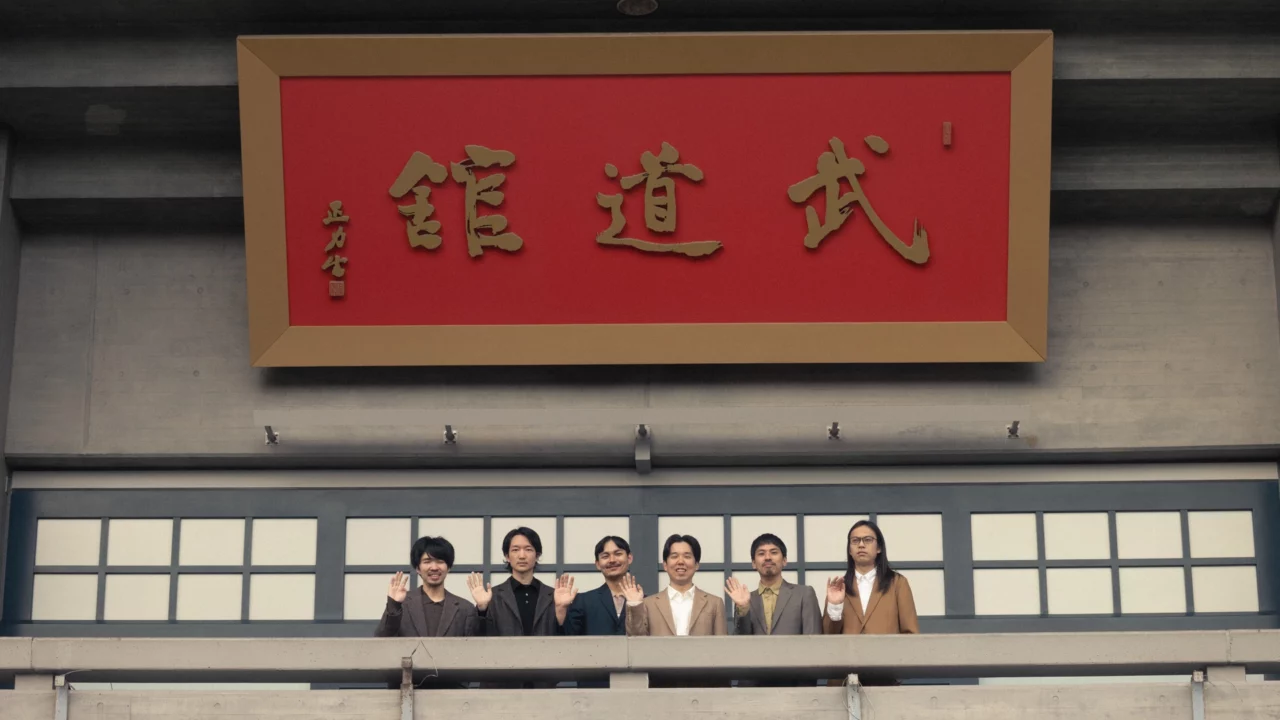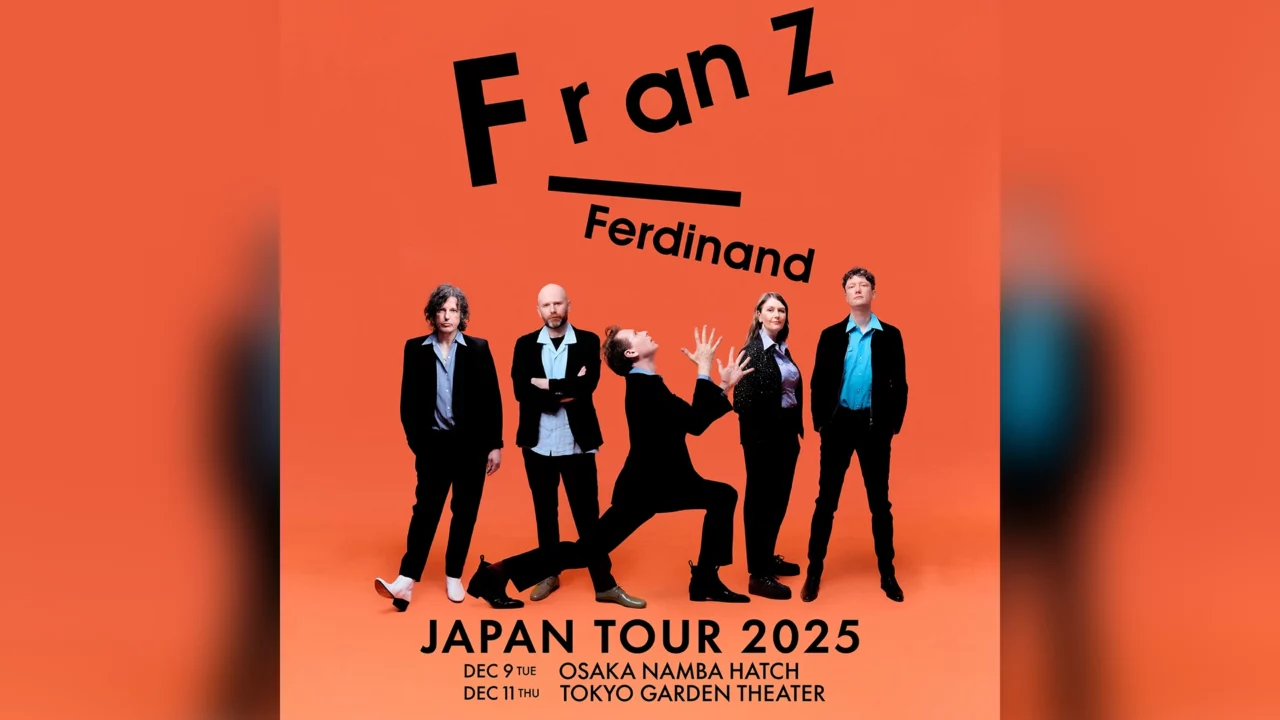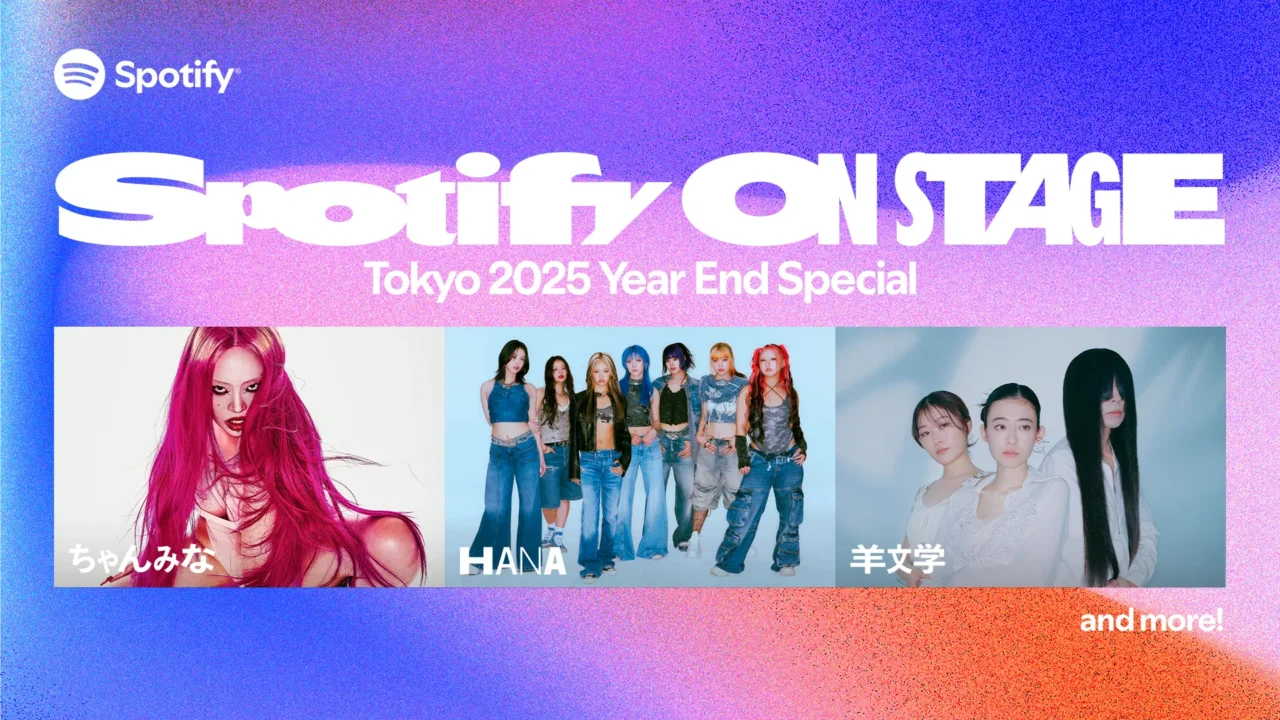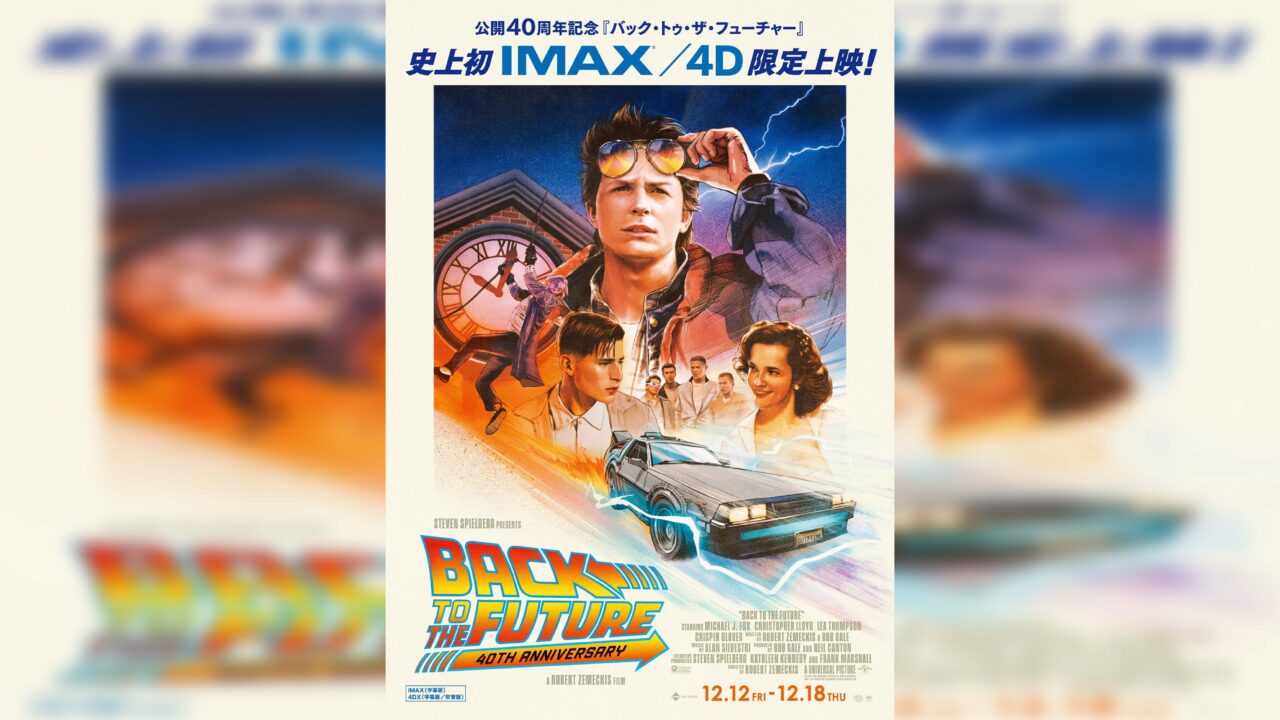Ever wondered how much you truly know about street art? The “Stream of Banksy Effect: The Evolution and Revolution of Street Art – Street Art (R)Evolution” exhibition at Shibuya Stream Hall in Tokyo is a rare, immersive experience that takes you on a journey through the origins, evolution, and current state of street art. It’s not just an exhibit – it’s a comprehensive lesson in the dynamic world of urban creativity.
INDEX
A Must-See for Art Lovers Beyond Street Art
Thanks to the influence of Banksy, street art has become a major presence in the contemporary art scene. This exhibition offers a unique opportunity to replace the vague idea of street art with a concrete viewing experience, helping you clarify what you think about it and what works you enjoy (or dislike).
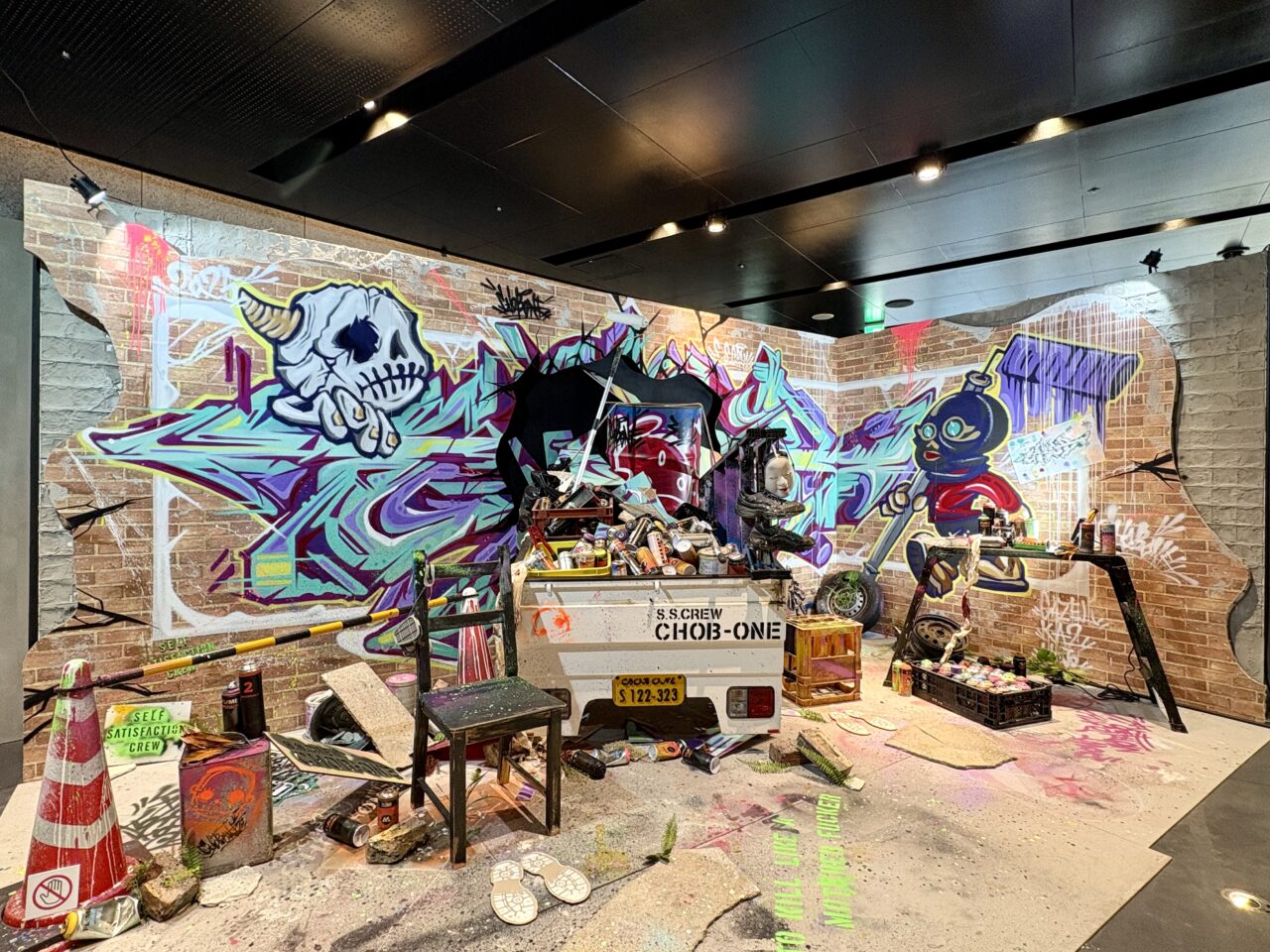
Personally, I believe this is a chance for art fans who have never considered street art to experience it. If you think of graffiti as just rebellious youth scribbling or illegal acts with no connection to you, this exhibition is especially for you! Maybe, in the end, we could find ourselves resonating more deeply with street art than we ever imagined.
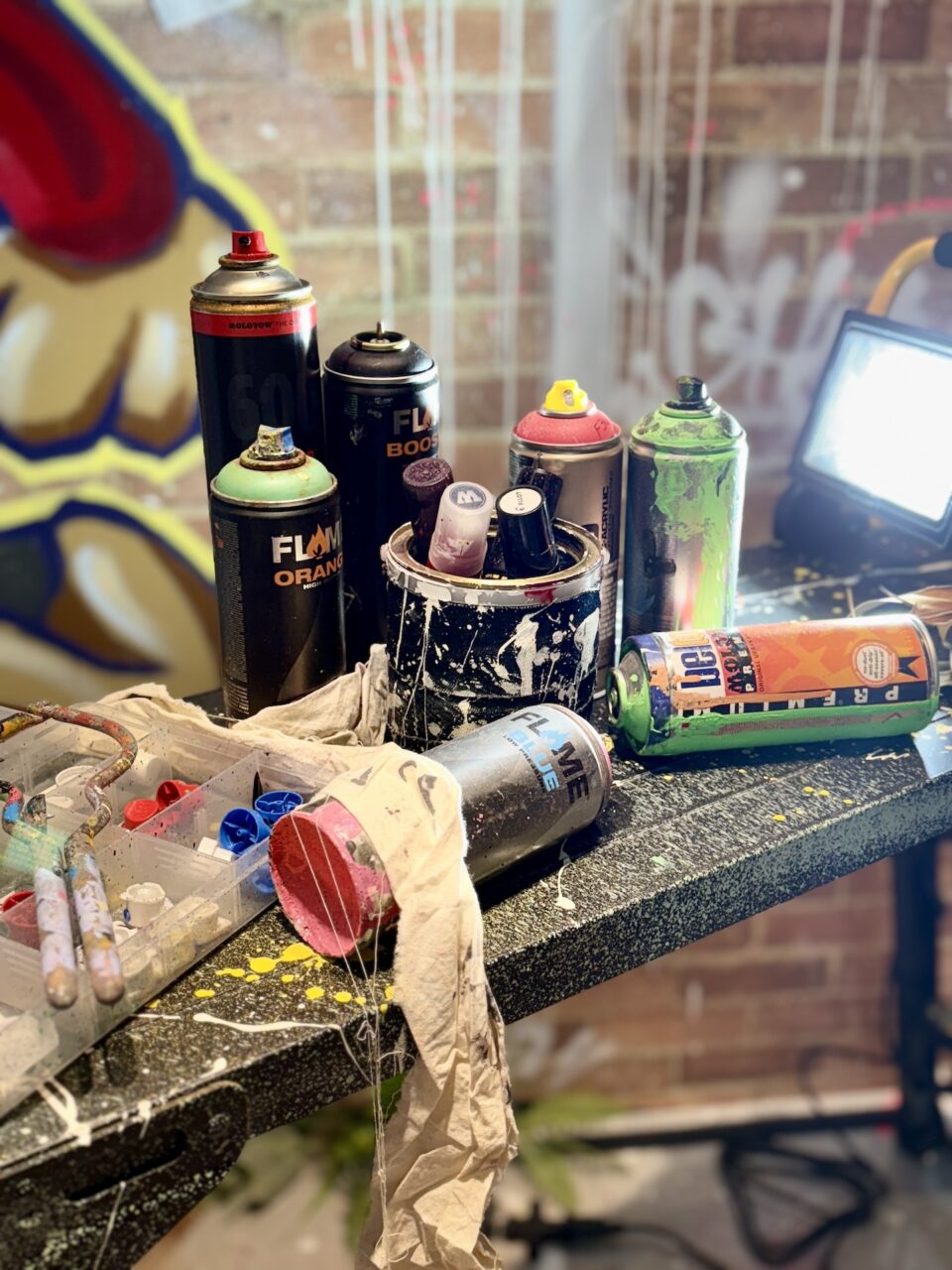
Everything placed in the photo booth is said to be a tool for creating graffiti art. When viewed together with the section displaying the tools later on, it provides a fascinating glimpse into the creative process.
INDEX
The Origins of Graffiti Art: A Form of Self-Expression for New York’s Youth
This exhibition is organized into about six sections, allowing visitors to follow the evolution of street art in roughly chronological order. Featuring 50 artists and approximately 100 works, the exhibition is quite extensive. It’s unfortunate that I can’t touch on every artist due to the length of this article, but below, I’ll highlight key points that seem to be particularly important for understanding the exhibition.
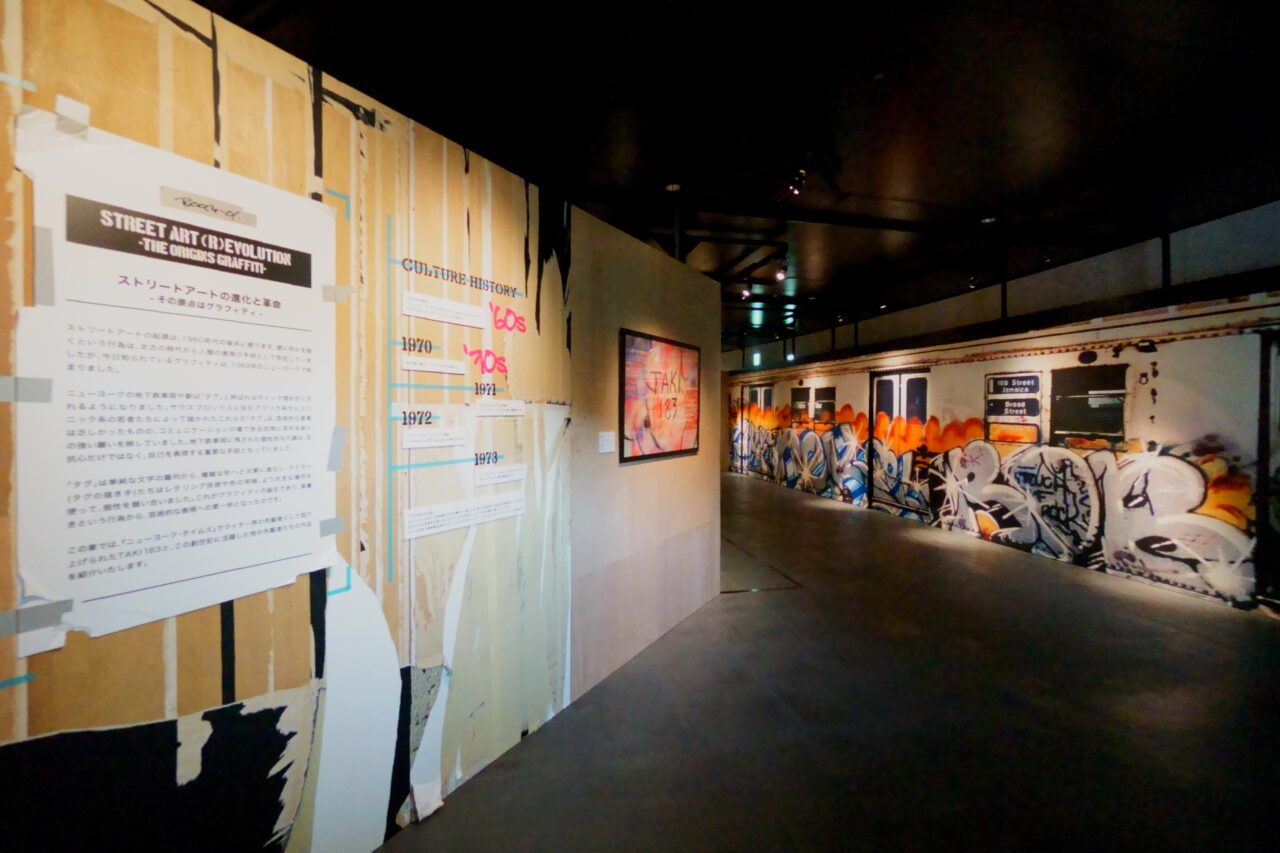
First, let’s look at the origin of it all: the “tag” born in New York in 1969. It was something like a sign, more art-like than actual art, drawn on subway cars and stations. I personally understood it as something similar to “I’m here!” written on tourist spots. However, this tag, which was a form of self-expression, began to symbolize territory among New York’s youth, evolving into an art battle where they competed with brighter colors and more intricate designs. This is when it started being called “graffiti art.” At the beginning of the exhibition, you can see works by TAKI183, who is known as one of the pioneers of tagging. Although it was later produced as a canvas artwork, the tag itself is simply something that was “just drawn.”
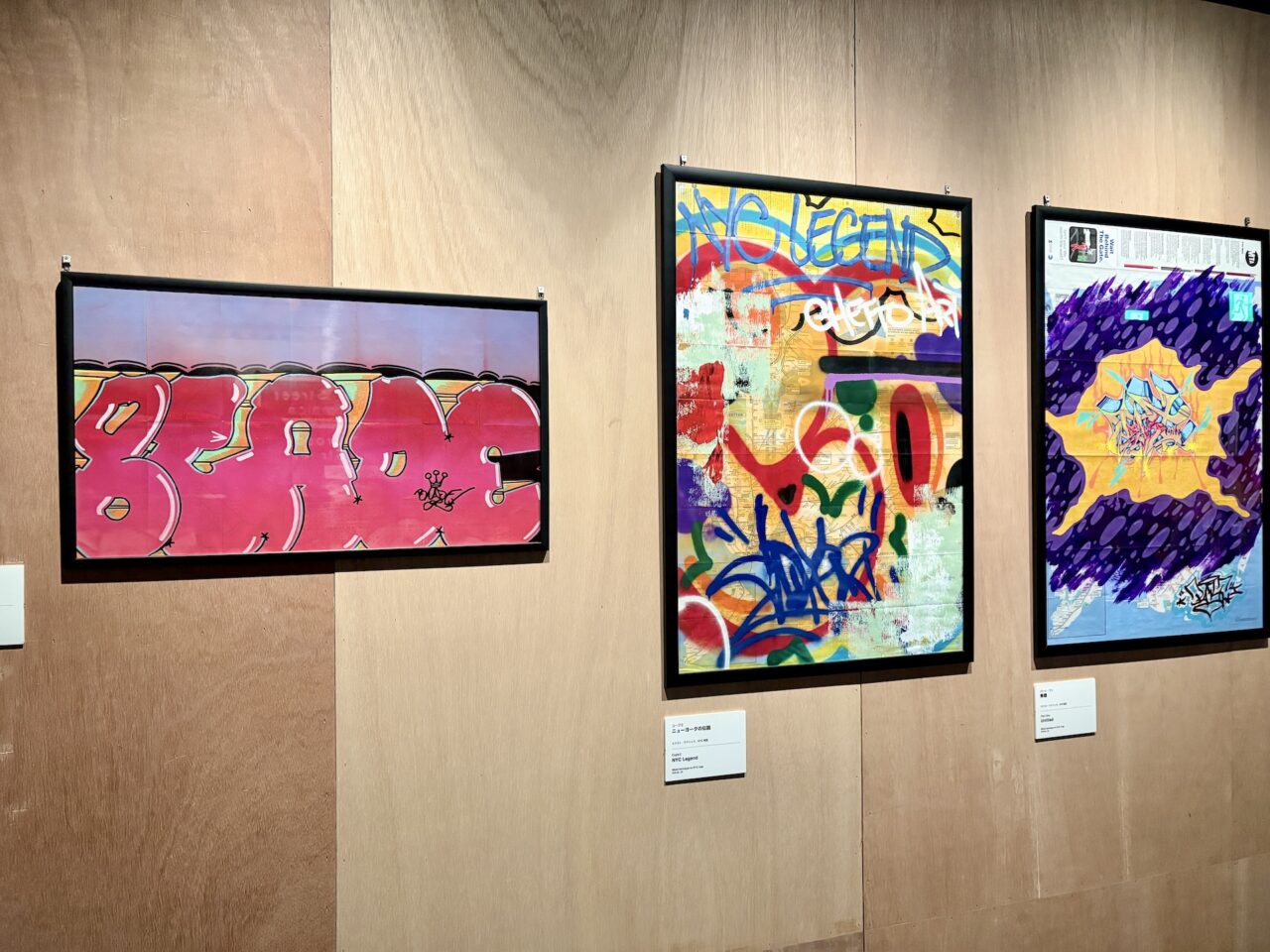
What’s particularly interesting are the early works of graffiti art at the beginning of the exhibition. Each piece is painted on a subway route map, similar to the free pamphlets you find at stations. With the roots of this art being in the “underground” nature of public spaces like the subway, the route maps were used as a medium for expression that wouldn’t be considered illegal. By the way, among the artists who came to Japan for this exhibition, some brought subway route maps from their own countries and used them as business cards, tagging them in the process. This episode really highlights how the act of tagging oneself and the local community lies at the core of graffiti as a creative activity.
INDEX
How Keith Haring and Basquiat Bridged Street and Art
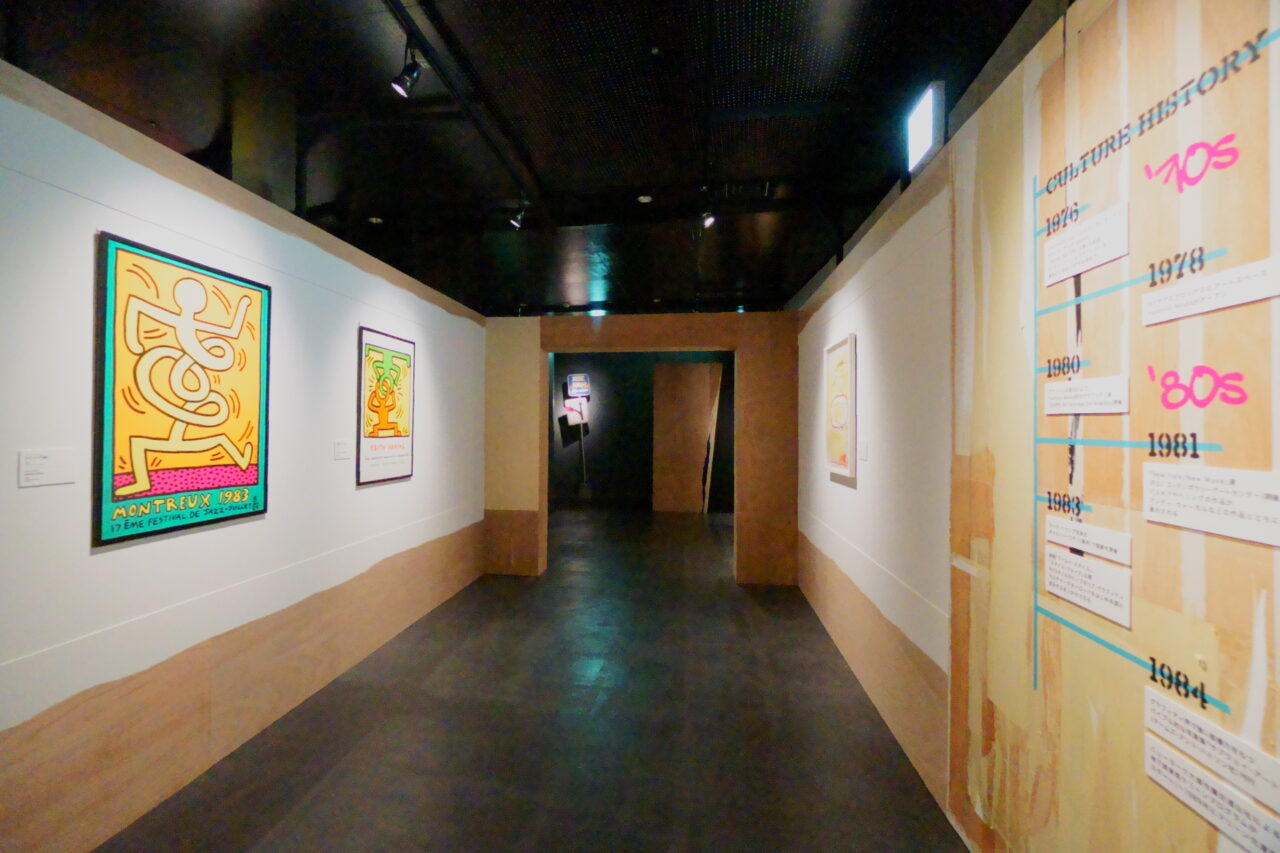
Graffiti art became more painterly as it evolved and was absorbed into the larger category of “street art.” The iconic figures that emerged from this era were Keith Haring and Jean-Michel Basquiat. Their arrival marked a turning point for street art, as it began to enter galleries and gain recognition as legitimate art, rather than just graffiti on street corners.
Though the exhibition features only a few works by Haring and Basquiat, their section stands out with gallery-style white walls, intuitively signaling the pivotal moment in the history of street art when this transition took place.
INDEX
A Message from the Marginalized at the Core

The style of street art eventually spread from the United States to Europe. The exhibition features works by renowned French street artists such as Speedy Graphito, Invader, JR, and Madame.
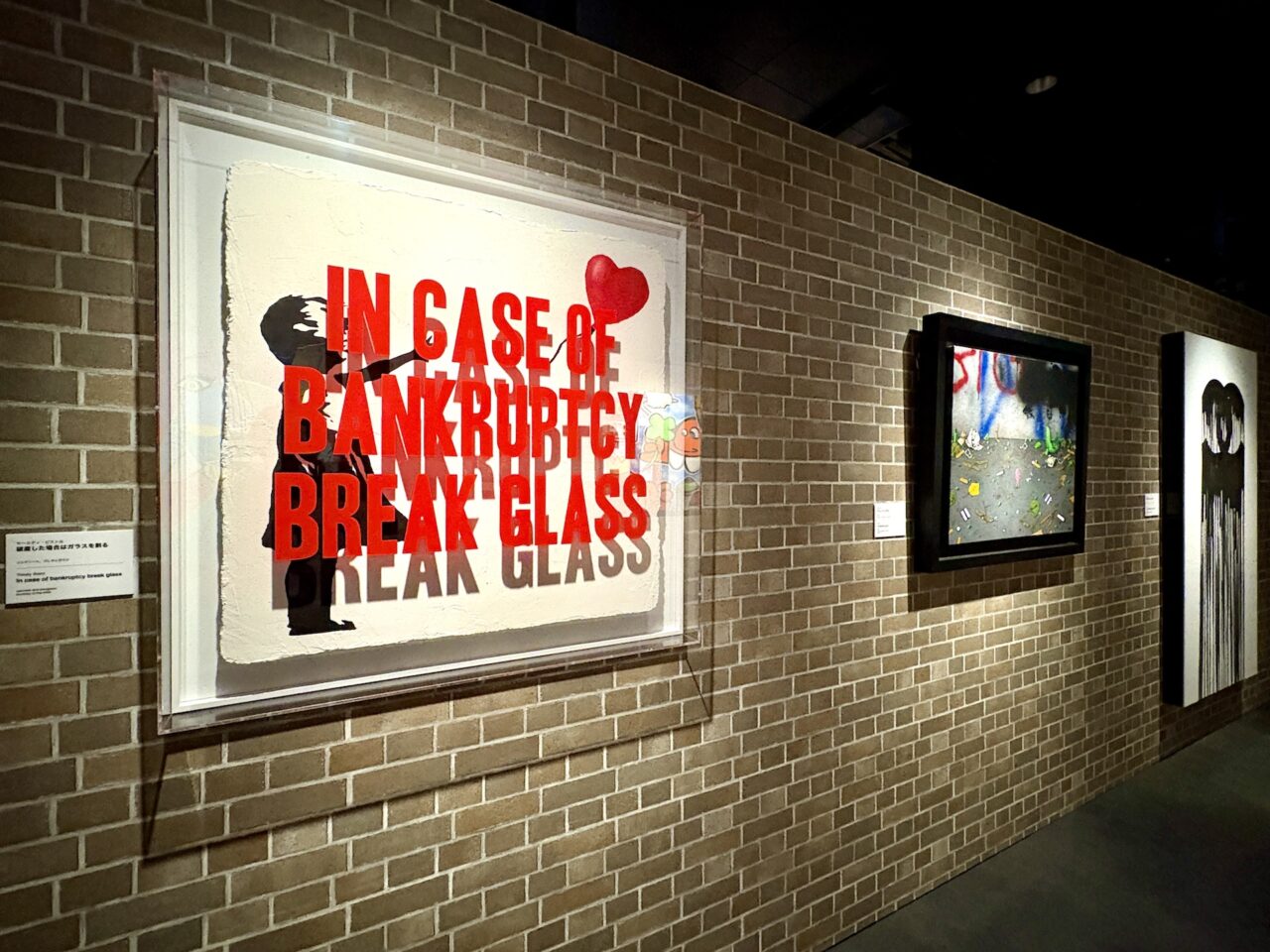
For example, let’s look at the work by Thirsty Bstrd titled “In Case of Bankruptcy Break Glass.” A large glass cover is placed in front of Banksy’s “Girl with Balloon,” with the words “IN CASE OF BANKRUPTCY BREAK GLASS” written on it (making it impossible to see the artwork…). It resembles the emergency buttons you see on trains, with the message “IN CASE OF EMERGENCY BREAK GLASS (Break the glass and press the button in case of emergency).” By linking Banksy and bankruptcy, this piece sharply critiques the art scene where Banksy’s works are bought and sold at record-breaking prices, reducing them to mere assets. In the background, Zevs’s “Liquefied Chanel Logo” is also straightforward, but it made me realize once again that much of street art stands with the marginalized, containing messages that seem to glare at society from a position of defiance.
INDEX
Tools that Reveal Pride in Creation
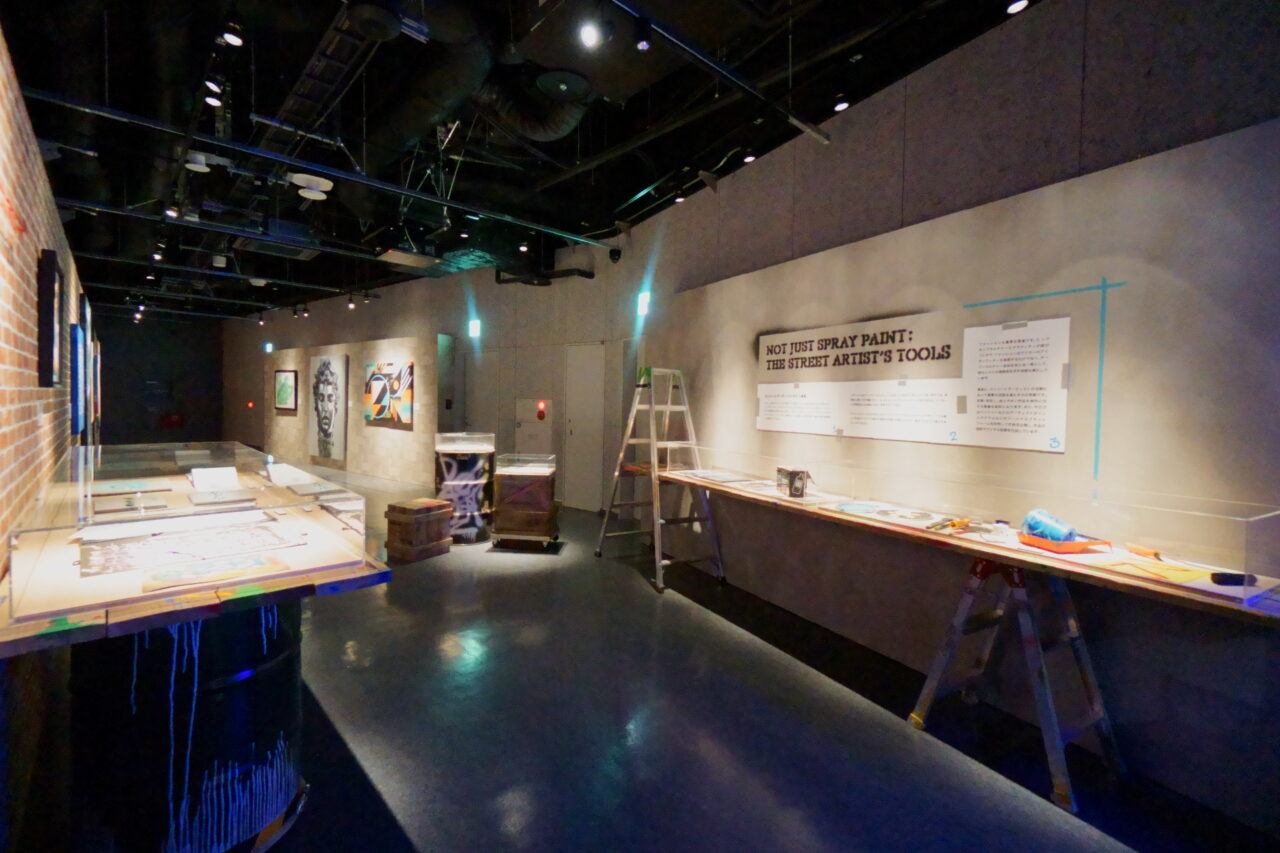
In the next area, tools and items used for creating street art are displayed along with examples of how they are used. You can really feel the artists’ dedication to their creativity, so be sure to take your time and carefully observe them!
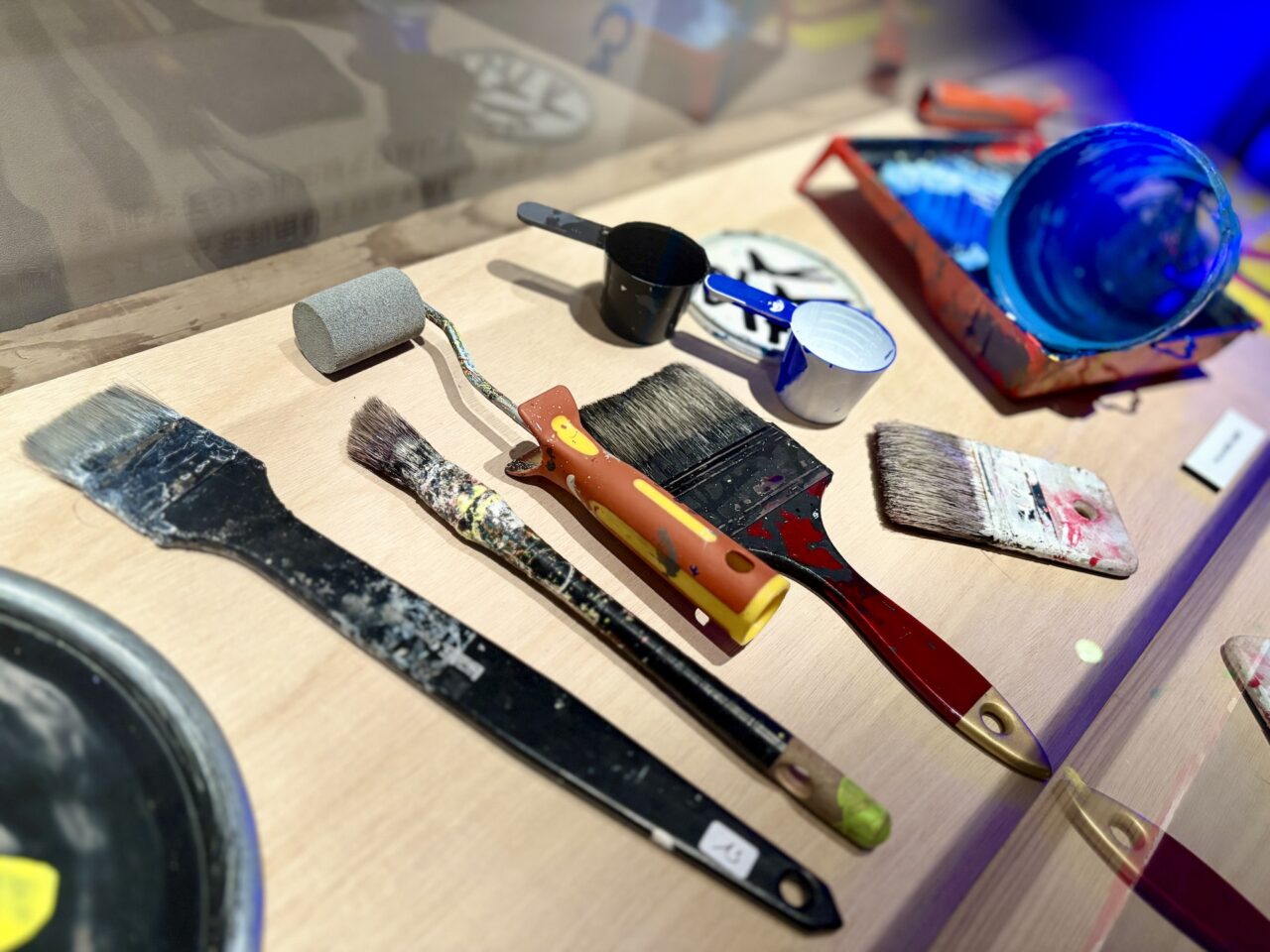
In the display cases, there are brushes and rollers showing the raw traces of creation, which were reportedly borrowed from the exhibiting artists. Additionally, numerous spray nozzle types are showcased. For street artists, nozzles are essential tools. The way colors spread is crucial to the final result, so many artists have a preferred manufacturer or even modify their nozzles themselves, demonstrating a craftsmanship-like attention to detail. This is a far cry from impulsively scribbled graffiti, revealing a true pride in their creations.
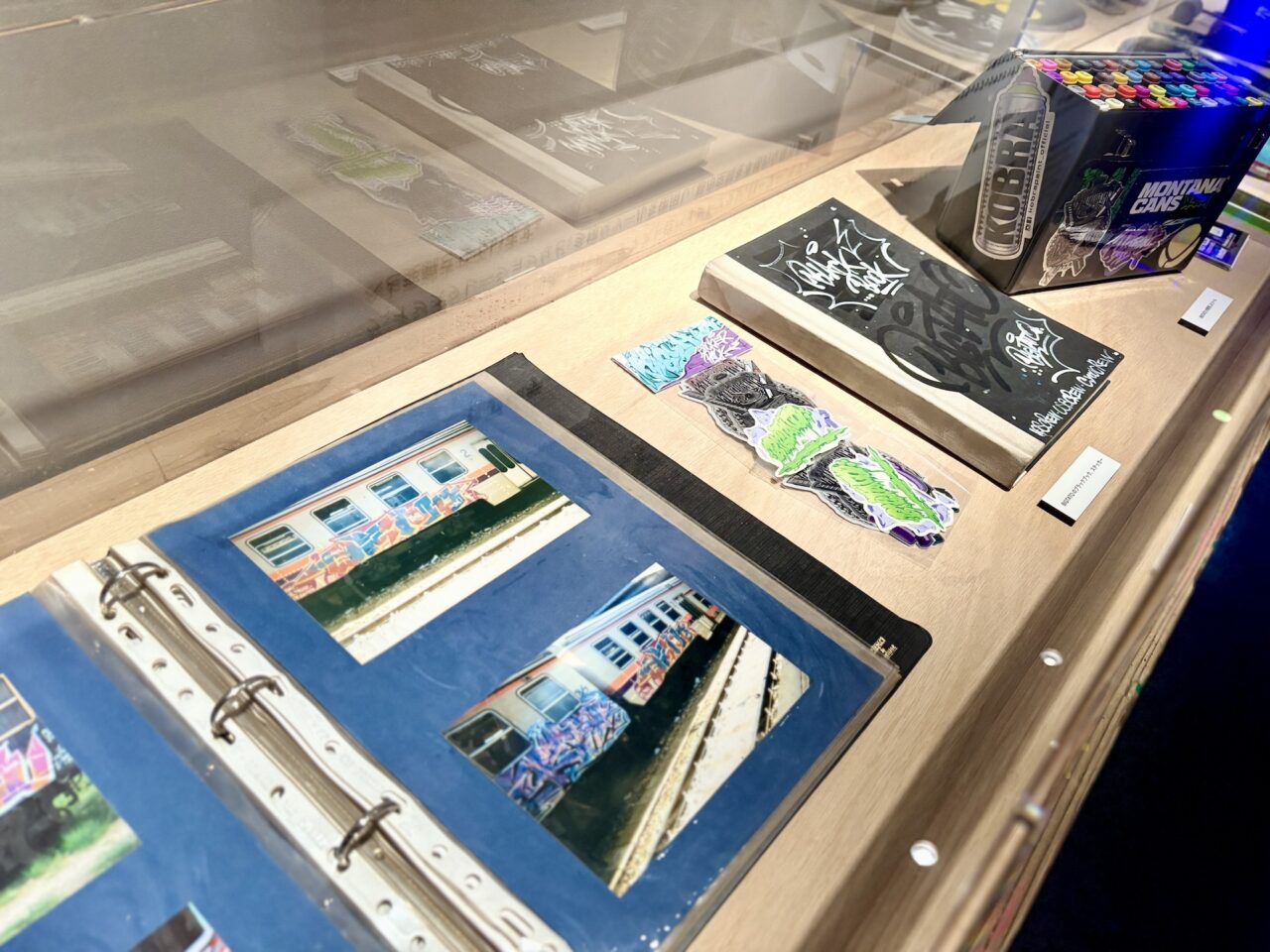
It’s incredibly rare to see a “blackbook,” a sketchbook where artists compile their drafts and ideas, displayed at an exhibition. Next to it is an album documenting the works an artist has painted on subway cars. Since it was borrowed under the condition of anonymity, the album’s creator is listed as “unknown”—naturally, because creating on subway cars is an illegal act. While I understand this, I can’t help but feel a strong sense of irony, as street art, which has gained such civic recognition that it can be showcased in an exhibition, could easily be deemed an illegal act. And here I am, standing before glass cases, viewing photographs of those illegal acts as valuable works.
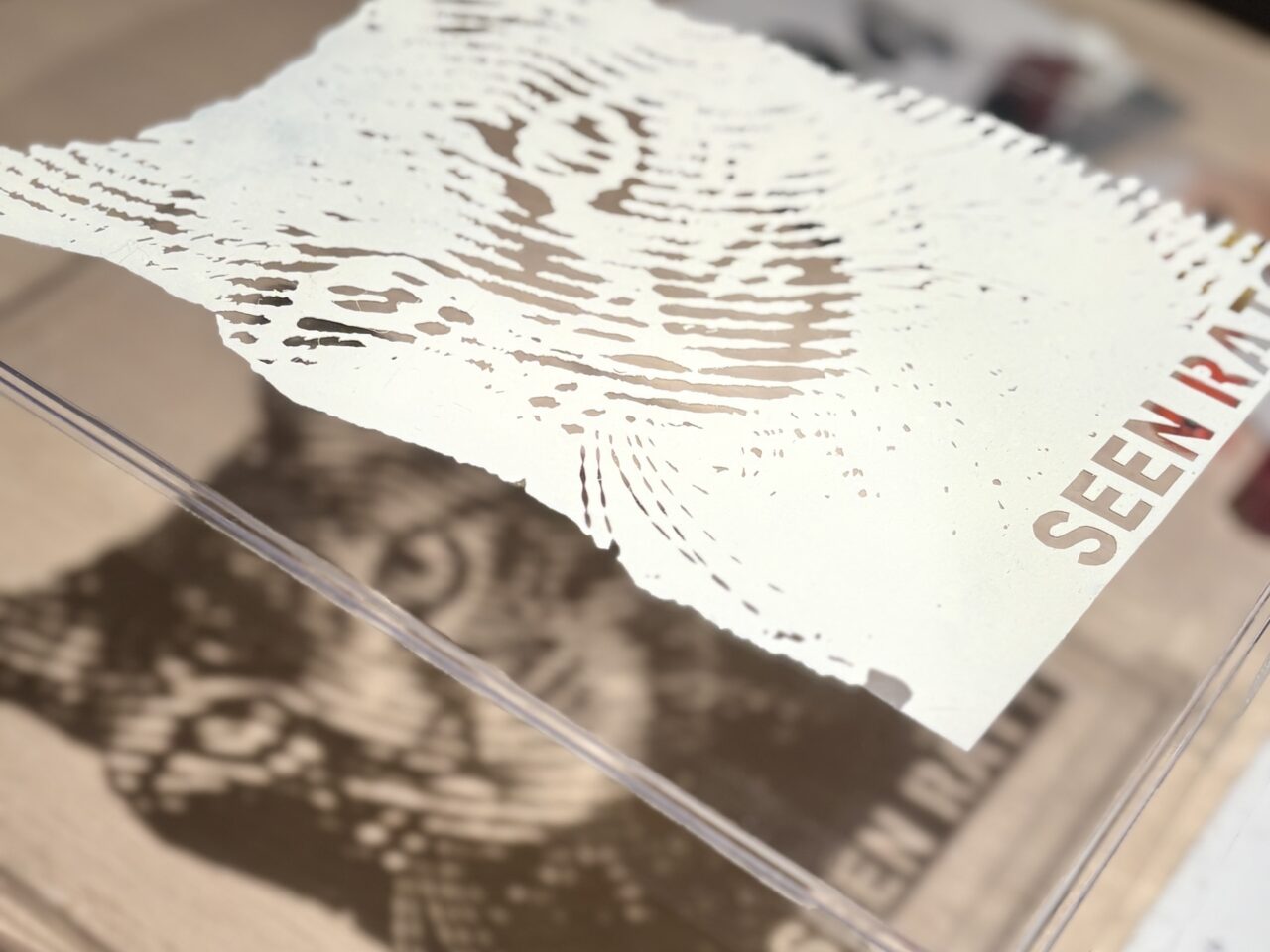
When it comes to street art, the stencil technique, which allows for quick work before getting caught, is essential. The stencils of Tokyo-born artist JIKKENRAT are displayed alongside their silhouettes for viewers to appreciate. In his studio, used stencils with paint scraped off and stuck to masking tape were once applied to windows, filling the room with stenciled images under the light. To recreate this fascinating scene, the exhibition’s organizers have put in great effort. Additionally, the finely cut stencils from Nevercrew are also a highlight and definitely worth paying attention to.
INDEX
The Evolution of Street Art into Diverse Expressions
The exhibition then moves on to the works of street artists who are currently active and receiving high praise. This is an area where you’ll want to observe with enough passion to remember both the names and the artworks. For example, Andrea Lavo Mattone’s works, which depict waves and Vermeer paintings with a soft touch, are all created using only spray paint, without the use of brushes. His style exudes a strong assertion and pride in being a street artist.
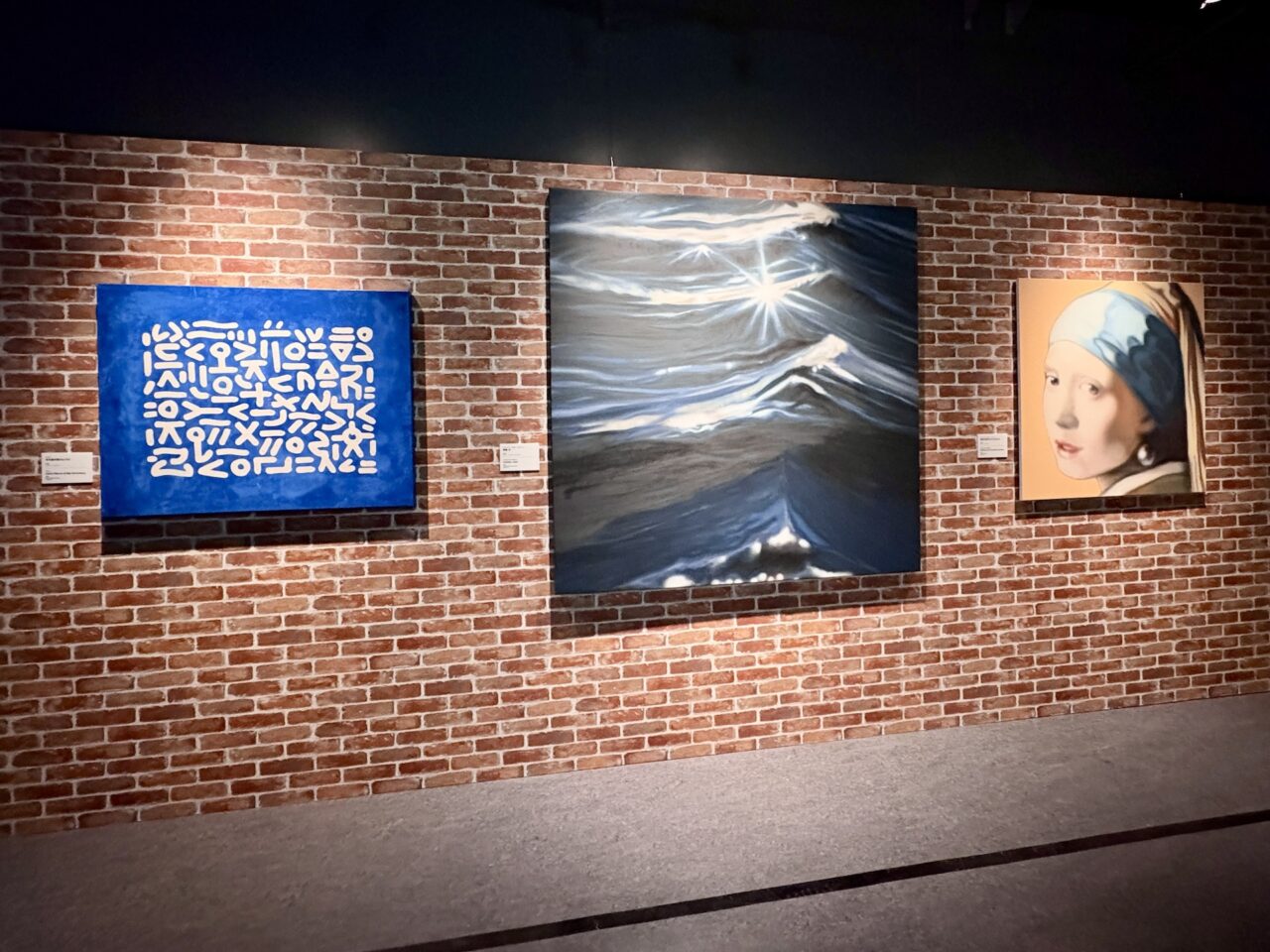
Also, a vibrant blue canvas featuring mysterious patterns resembling Hangul characters is the work of Raul. For the artist, creating this unique script carries a meaning of healing and a prayer for peace. During the exhibition, a large-scale piece of the same type is displayed on the floor of Shibuya Stream’s public space. It was a curious sight to see this “mysterious ritualistic pattern” unfolding at the feet of hurried commuters and people gathering at the terrace seats of Starbucks. If more people come to understand and believe in its meaning, perhaps one day it will truly become a magical incantation.
INDEX
Here comes Banksy!
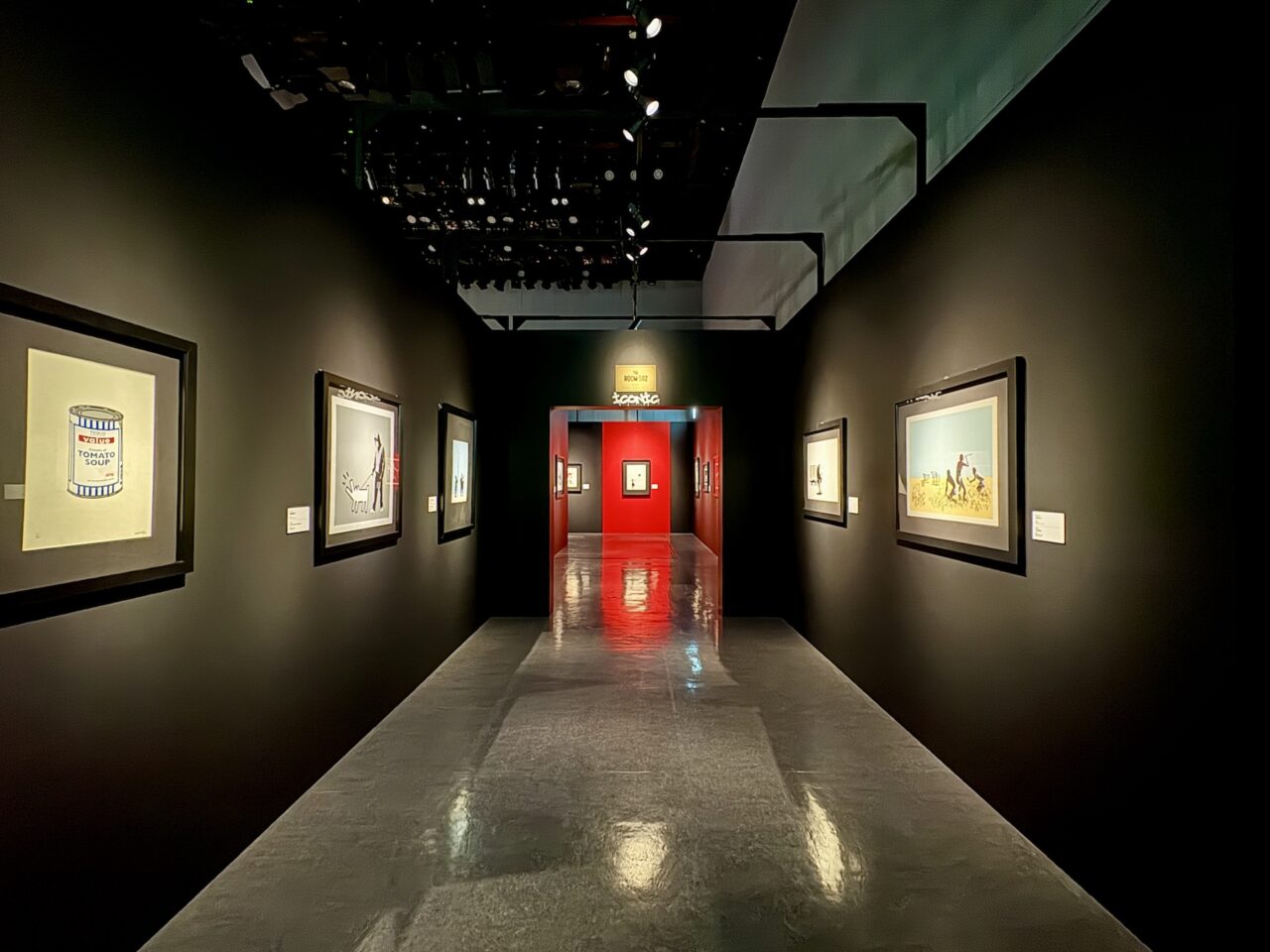
Finally, we enter the exhibition area featuring the majority of the works by Banksy. There are over 30 pieces in this section alone, displayed according to themes such as “CONSUMERISM” and “WAR.” Additionally, in the area focusing on the relationship between street art and hip-hop, visitors can also see LP covers designed by Banksy.
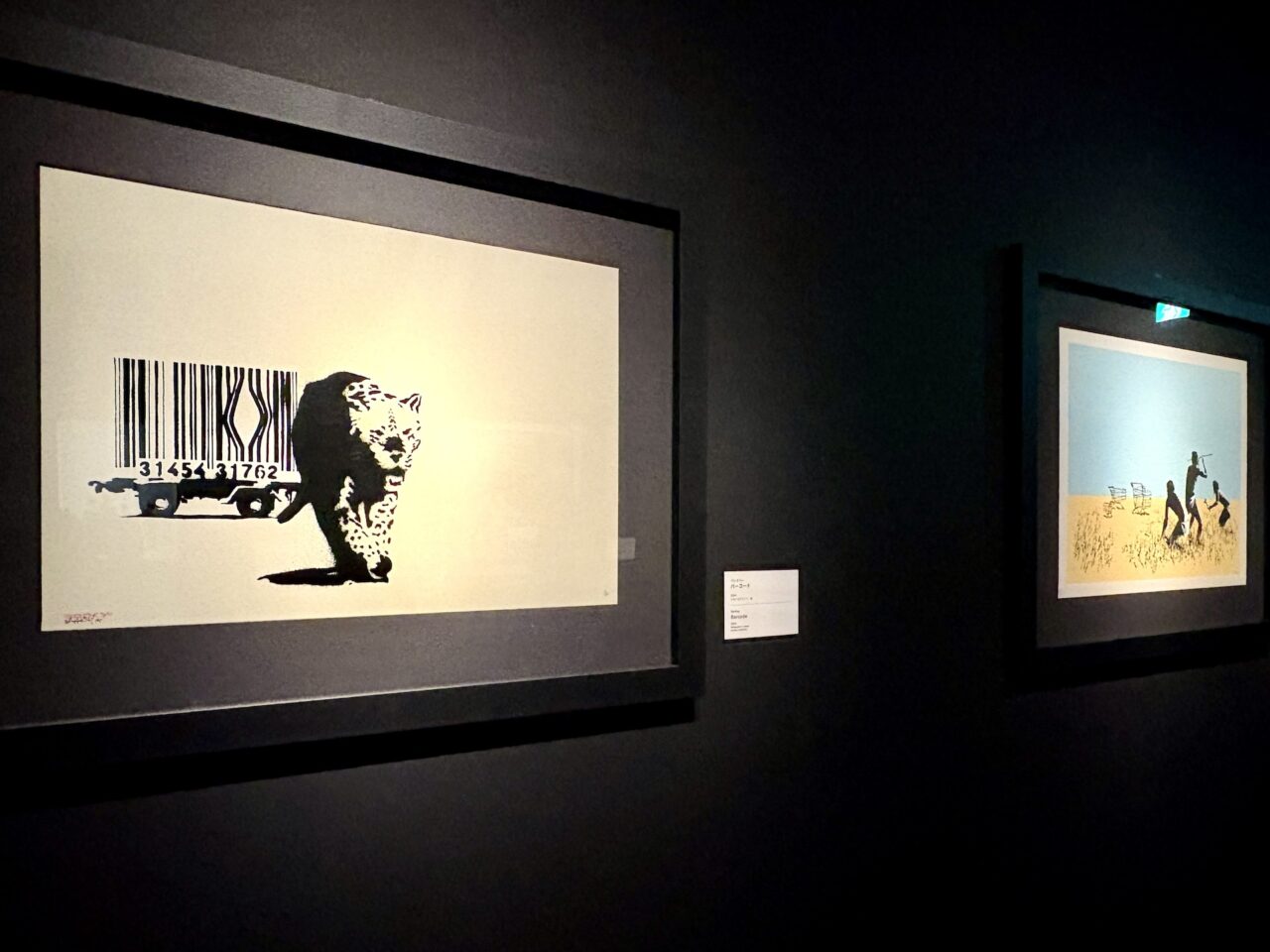
Personally, I discovered my favorite series, the barcode series. A leopard breaks free from the barcode cage and starts walking. A similar work combining barcodes with a shark is also famous, and in both cases, the creatures that appear are dangerous, man-eating predators. From this, one can interpret a message urging us to become aware of the malice and danger lurking within the consumption system.
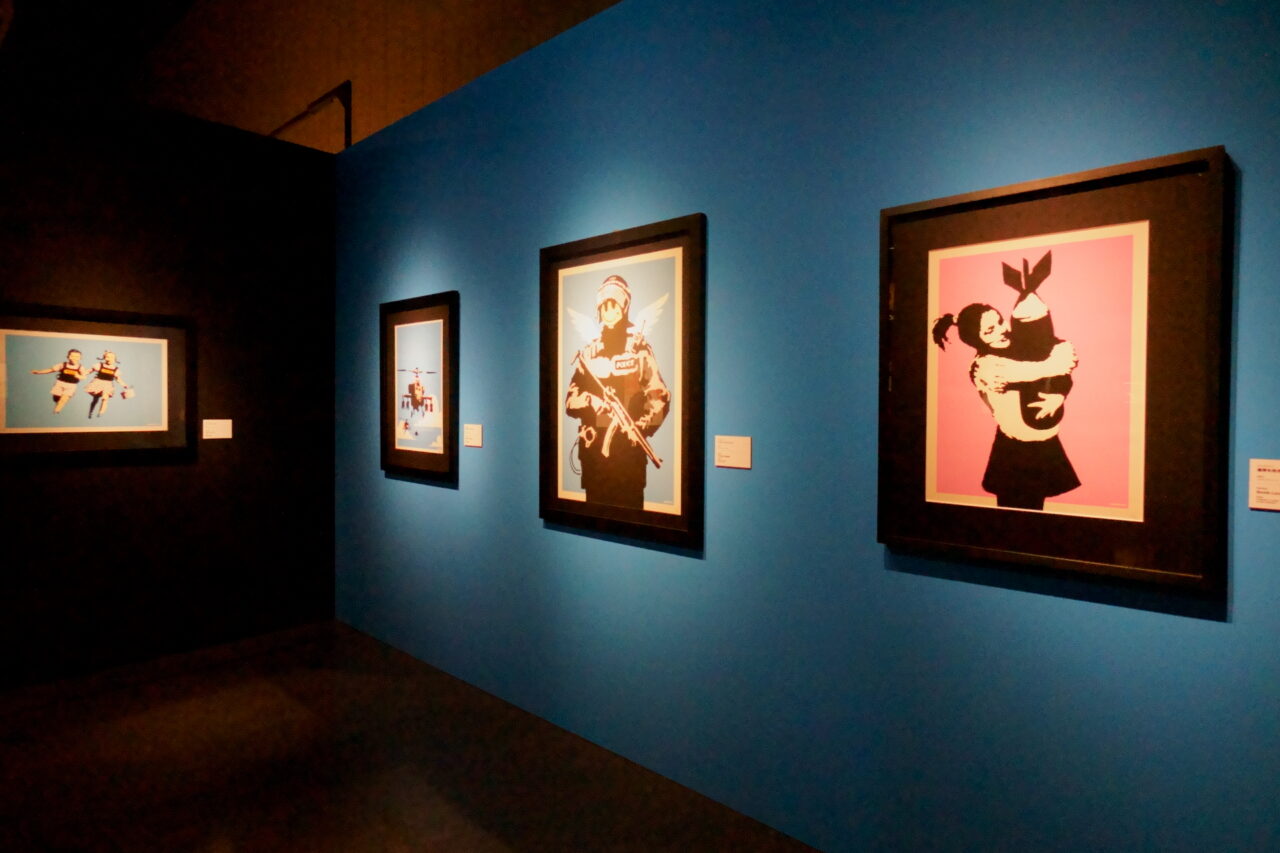
Banksy’s works are often conceived by combining elements that wouldn’t normally go together. A girl hugging a bomb as if it were a plush toy, a policeman with angel wings and a smiley face aiming a gun, a helicopter adorned with a giant ribbon—these jarring images make you stop in your tracks. You start putting into words why exactly they feel unsettling. If you’re with someone, you might find that what stands out to them is completely different from what catches your eye. As you engage with the works, before you know it, you’re confronting bigger questions than you expected—”What is happiness?” “What is violence?” Banksy’s name is often discussed in terms of auction prices, but ultimately, the sharpness of his artistic vision speaks for itself.
Banksy is an artist living in the same era as we are. There’s no such thing as not understanding his historical context or references—because they are the same ones we experience in real-time. There’s almost nothing he knows about modern society that we fundamentally couldn’t know ourselves (unless, of course, he happens to be a political leader or a state-secret-holding spy). And yet, there were moments when I felt frustrated, unable to fully grasp the meaning behind certain pieces. It made me realize that my awareness and knowledge in those areas are lacking. I want to be someone who can always respond vividly to Banksy’s thought-provoking visual riddles.
INDEX
Street Art in Japan: Right Next to Us
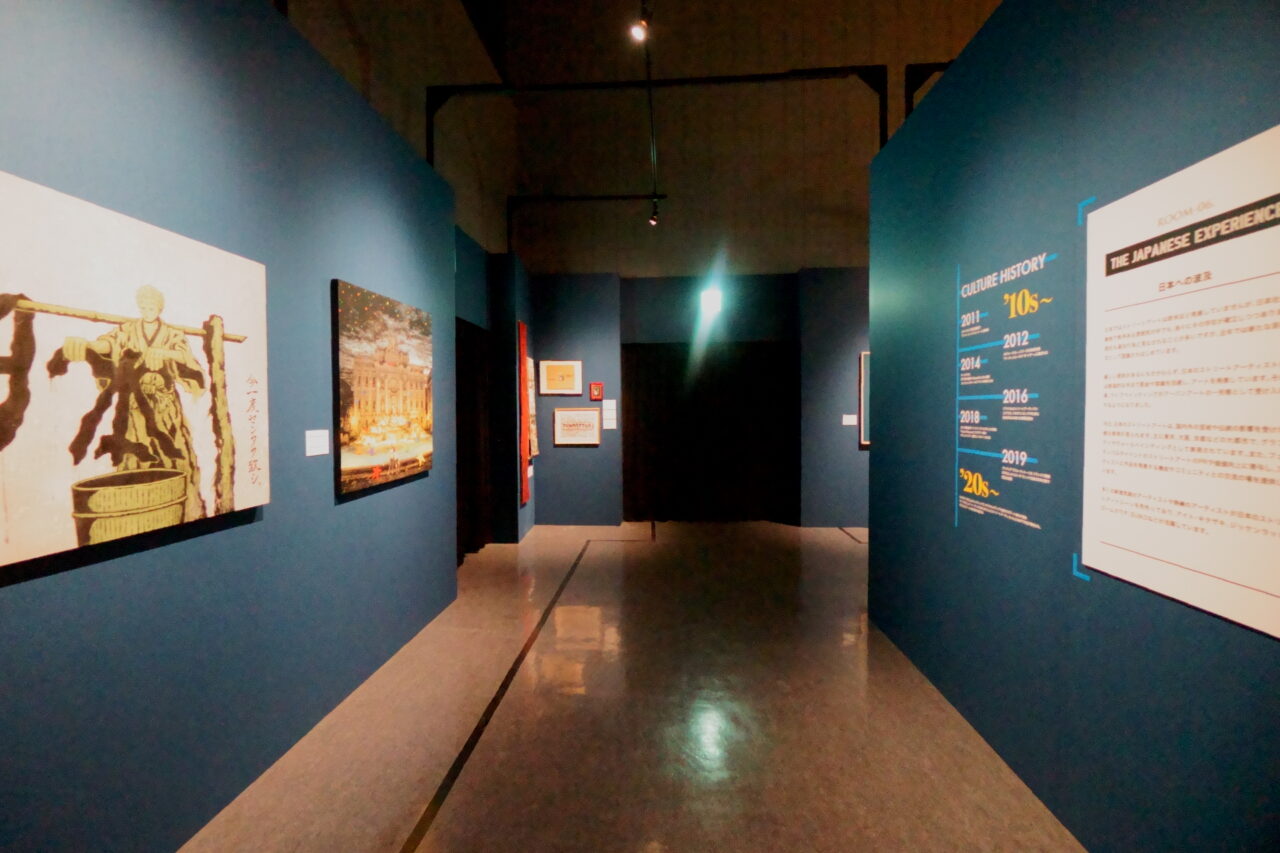
In the final section of the exhibition, five Japanese artists currently active in the street art scene are introduced. Compared to other countries, Japan’s street art scene is still in its early stages—partly due to what the exhibition panel describes as the country’s “strict and orderly social atmosphere.” However, street art is steadily gaining recognition as an art form and gradually becoming integrated into the urban landscape.
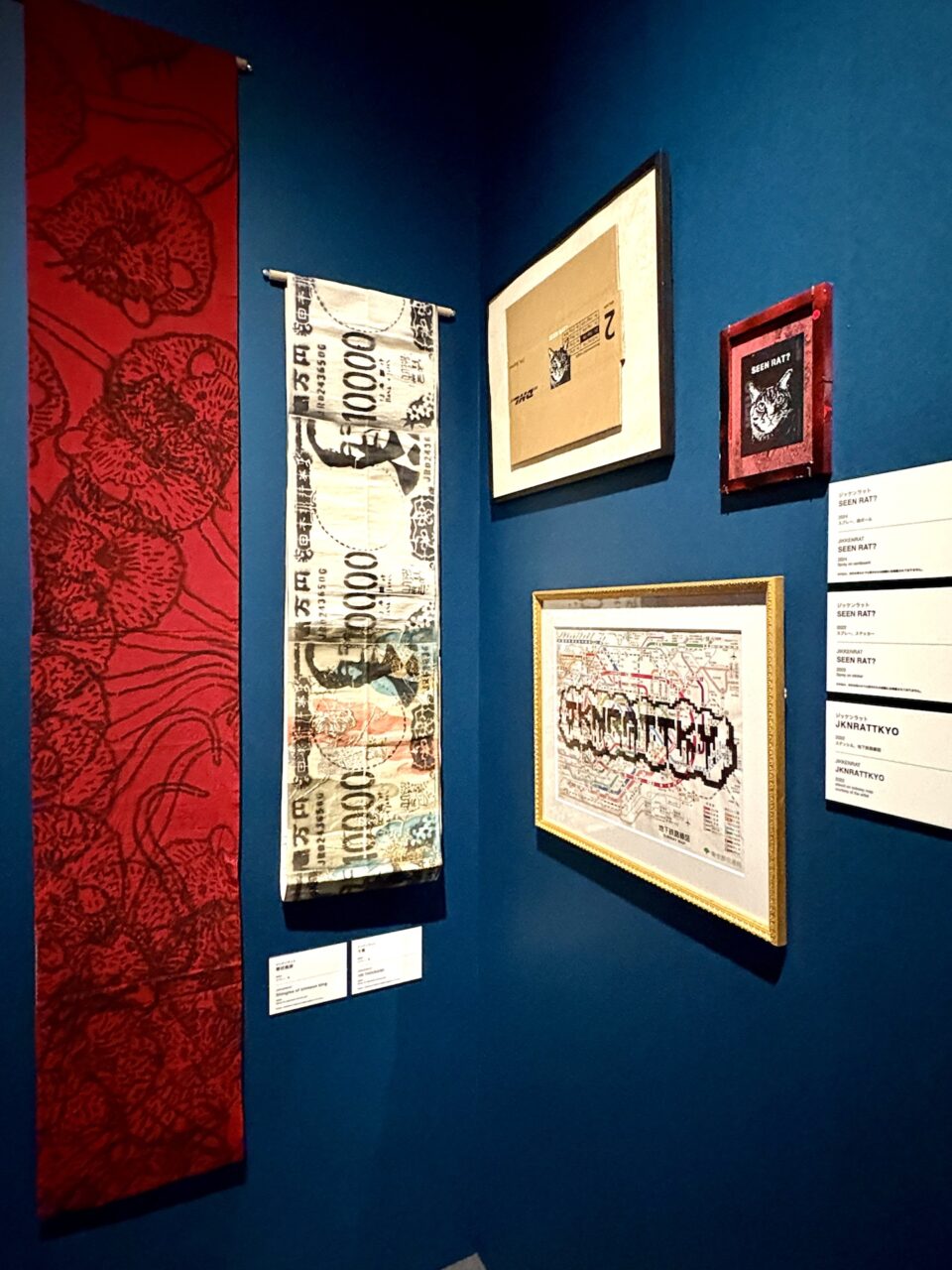
One of the most striking pieces is JIKKENRAT’s work, which features graffiti painted over a Tokyo subway map. It consciously carries on the spirit of “I am here!”—a mindset that first emerged in New York in 1969—making it a work that embodies the very origins of street art.
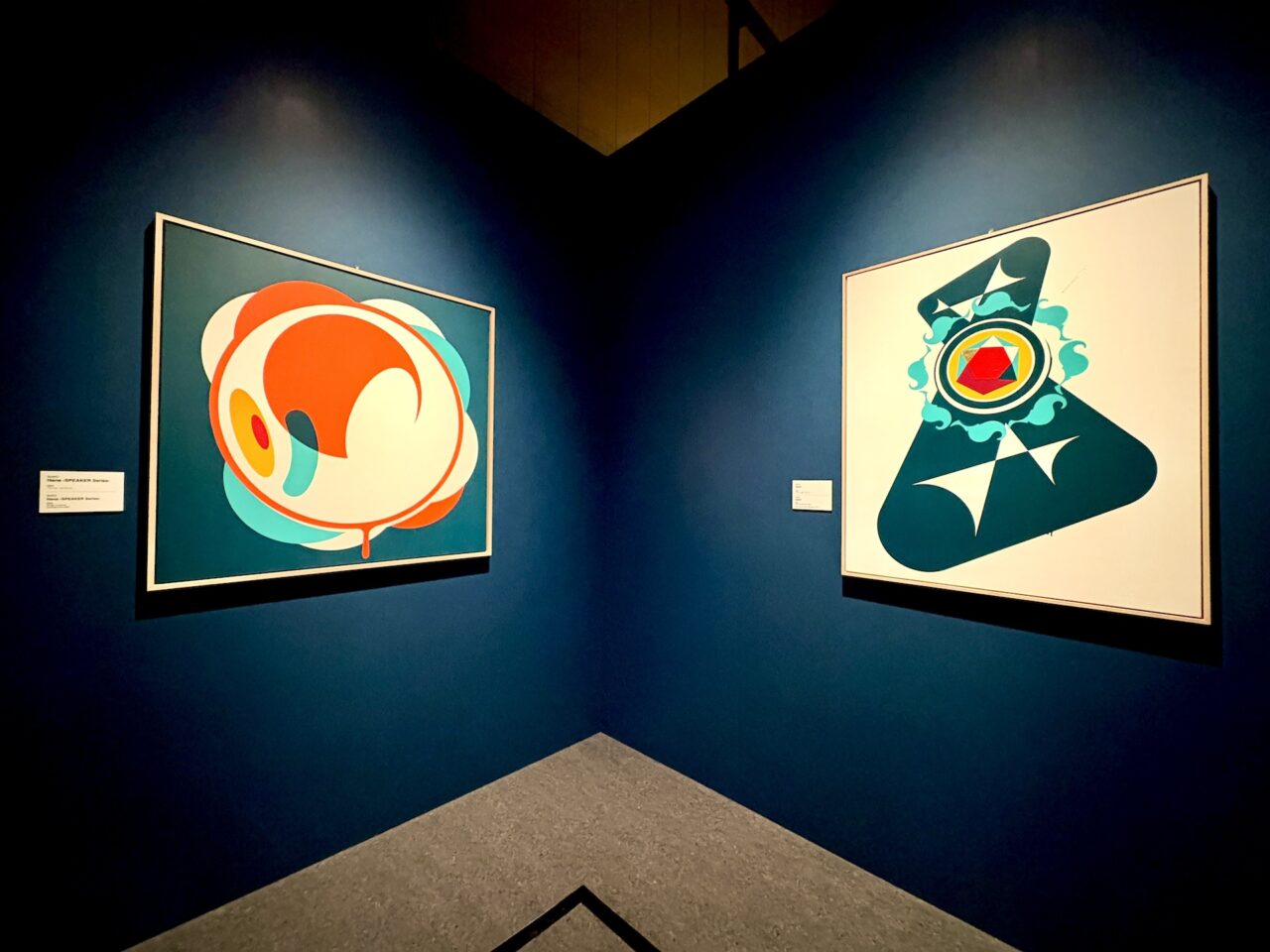
Also featured are two works by SUIKO, an artist who has been gaining prominence after creating a massive mural at Murasaki Park Tachikawa-Tappi, Japan’s largest skateboarding facility, which opened last year. His vibrant colors and forms that seem to exist between organic and inorganic elements make his work especially captivating.
Near the exhibition exit, visitors can also watch a film documenting the creation process of a floor mural by SUIKO, edited specifically for this exhibition. The project took place at a skate park in Matsuyama City, Ehime Prefecture.
INDEX
Street Art is Inherently Local
In the final exhibition space, the works of one of Japan’s leading artists, Katsuhiko Hibino, are showcased. During the exhibition, a new live painting session by the artist is also scheduled, making it an area to watch closely.

Katsuhiko Hibino’s “The Brain Can Be Fooled, But the Body Can’t #01” features the artist wearing VR goggles and painting in a virtual space while simultaneously painting on a flat surface in the real world. It is recommended to experience this work alongside the video that captures the live painting process.
Hibino, who agreed to join the exhibition at the organizer’s request, aims to present the future potential of street art. The key to this future possibility is likely “locality.”
Known for his art using cardboard, Hibino has recently focused on projects deeply connected to local communities, aiming to create expressions that connect people and places through art. Street art’s origins, in tags and graffiti, held meaning in linking one’s fleeting existence to specific times and places. Given that it was initially painted on the streets, street art is fundamentally a local form born from the chemical reaction of “now × here × self.” Even as it gains influence in society, attains higher value, and becomes actively integrated into public spaces, this core aspect will remain unchanged. For this reason, the organizer sees in artists like Hibino, who stay close to the community and seek to address social issues and promote local charm, a model for the future evolution of street art.


